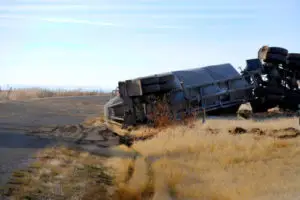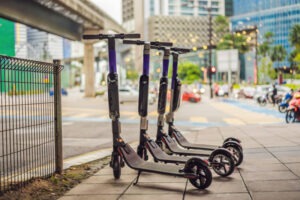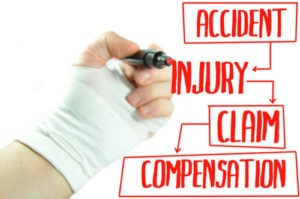
When a passenger vehicle rolls over, the resulting accident often causes substantial damage to the vehicle and its occupants. When a big truck rolls over, the resulting accident can not only damage the truck itself, but also everything in its path. While many vehicle rollover accidents involve only a single vehicle, when a truck rolls over, other drivers may struggle to get out of the way.
Common Truck Rollover Accident Causes
Many factors can lead to rollover accidents, including truck rollovers. Because big trucks sit higher than a passenger vehicle, they also have a higher center of gravity. Flatbed trucks hauling unbalanced loads, including construction equipment, may have greater odds of becoming involved in a vehicle rollover accident. Any truck, however, can roll over under the wrong circumstances.
Weather Conditions
In dangerous weather conditions, the risks of rollover accidents increase substantially. Big truck drivers often continue traveling regardless of weather: Even in icy or rainy conditions, drivers must still meet their deadlines and take care of their responsibilities. Drivers who do not drive generally do not get paid for their time, even if rain or snow caused their delay. On wet roads, tires slip more easily. Drivers may have to exercise more care to safely navigate turns, especially near steep inclines or drops.
High wind conditions can also contribute substantially to the risk of rollover accidents. Because of a truck’s large profile, high winds can easily catch the truck, unbalancing it and sometimes causing it to roll. Trucks with already unbalanced loads have a substantially greater risk of high winds rolling them over.
Excess Speed
The faster a vehicle moves, the greater the odds of that vehicle becoming involved in an accident. At higher speeds, drivers need to react faster than at slower rates of speed. Big trucks, which already require more stopping and maneuvering room than passenger vehicles, greatly increase the danger to themselves or others around them when they speed. Most of the time, trucks are subject to a slower safe speed on winding roads and when taking turns than passenger vehicles. Drivers may, however, attempt to maintain the same speed as passenger vehicles around them to avoid slowing down traffic. When one or more of a truck’s wheels lose full contact with the road at high speeds, the resulting imbalance increases the risk of a rollover accident.
Jackknife Accidents
Jackknife accidents, when a truck’s trailer swings around independently of the truck forming the truck into a V shape, can often end in rollovers. With the trailer out of control, the driver can no longer control or predict what happens to the truck’s mass. In many cases, the trailer weighs more than the truck itself, making it almost impossible to pull trailer back under control.
Driver Error
Truck drivers spend many hours every day on the road—up to 11 hours out of a 14 hour shift. Long hours on the road can make it difficult for drivers to pay attention to everything going on around them. Driver distractions, including eating and drinking in the vehicle, fiddling with a cell phone, or even changing the station on the radio can lead to serious errors. Failing to notice an obstacle in the road or compensating too late for a turn can quickly lead to a rollover accident.
Shifting Cargo
The way a truck’s cargo is loaded requires just as much care as maintenance on the truck itself. Poorly-loaded cargo can unbalance the truck, leaving it at a higher risk for a rollover accident. And, if loaders fail to properly secure the cargo, the cargo shift and can cause the trailer to tip or rock, increasing the risk of a rollover. In some cases, shifting cargo alone can cause the accident. In other cases, improperly secured cargo may shift when the truck driver performs a dangerous maneuver, contributing to the chain of events that lead to an accident.
Mechanical Problems
Big trucks have many component parts that must work together to keep the truck on the road safely. Some mechanical failures can contribute to rollover accidents, including brake failures that cause a truck to move into a turn too fast, missing headlights or windshield wipers that impair visibility, and tire blowouts, which may make it difficult for the driver to control the vehicle.
Expect More, Receive More: Legal Support That Feels Like Family
Avoiding Truck Rollover Accidents
Most drivers have little choice about sharing the road with big trucks, especially on a drive that includes a highway. While you cannot prevent factors like truck driver error or poor weather conditions, you can take several steps to decrease the risk of your being involved in a truck rollover accident.
1. Slow down.
Many drivers struggle with sharing the road with big trucks because they feel those trucks slow down their drive, especially on long commutes or road trips. As a result, many drivers attempt to zip around big trucks or try to force truck drivers into moving faster than they are comfortable driving. High rates of speed, however, can contribute substantially to many types of accidents. When out on the road, slow down. Do not try to force a truck to get out of your way, even if it means waiting a few more minutes to reach your destination safely.
2. Avoid sitting in the truck’s blind spots.
On long drives, especially in heavy traffic, you may find yourself staying in approximately the same place relative to other cars around you. In spite of heavy traffic, however, you still have a choice about whether you sit in a truck’s blind spots. Look up along the truck. Can you see the truck driver in the truck’s mirrors? If you cannot see the driver, they cannot see you. While sitting in a truck’s blind spot will not automatically cause the truck to roll over, it can prevent the driver from knowing about your presence. If the driver tries to change lanes on top of you, then overreacts to recognizing your presence before completing the lane change, it can cause the truck’s wheels to slip off the road, ultimately leading to a rollover accident.
3. Do not pass trucks next to a sharp drop.
When you share the road with big trucks, focus on passing safely. When you note a steep drop to the side, try to avoid passing trucks on that side. You should also make sure that you stay in your lane when passing trucks on the opposite side from a big drop, which can help keep the truck safer.
4. Give truck drivers plenty of room to make turns, especially right turns.
Rollover accidents may occur because truck drivers try to make a turn without enough space to safely complete that turn, often based on the patterns of other drivers around them. Instead of remaining tight to truck drivers, give the truck plenty of space to safely make the turn. This can decrease the risk of jackknife accidents and other factors that can lead to rollover accidents.
5. Take a look at the truck’s cargo when traveling beside it.
If you’re traveling beside a flatbed truck, make a note of the truck’s cargo. Is it carrying heavy or unbalanced equipment? Do you notice the equipment swaying dangerously? If so, you may want to avoid traveling alongside the truck, especially if you notice an incline or drop at the side of the road. Signal the driver if you notice problems with the cargo that could cause an accident, including cargo that looks like it may fall from the truck. Drivers typically check the straps securing cargo to the back of a flatbed when they stop; however, if straps loosen over the course of a drive, cargo can become unbalanced, leading to a rollover accident.
Taking Steps to Protect Yourself After a Rollover Accident
When a big truck rolls over, it may cause damage to everything in its path, including other vehicles. A truck driver struggling to bring the truck back under control may inadvertently strike other vehicles before ultimately rolling the truck. If your vehicle is involved in a truck rollover accident, even if only in a minor way, take these steps to protect yourself:
1. Do not leave the scene of the accident unless you need to seek immediate medical attention.
In some cases, the driver may clip your vehicle during a jackknife accident or sideswipe your vehicle before rolling. This can cause relatively minor damage. However, even if you suffered only minor damage in an accident, you should not leave the scene of the accident until the police arrive. But if you need medical attention, that should be at the top of your priority list: you can leave the scene of an accident to get to a hospital or urgent care facility if you need immediate medical care for your injuries.
2. Move to a safe location, if you can.
Do not put yourself in danger by trying to navigate dangerous terrain alone, especially if you have serious injuries from your accident. Do not approach the truck, especially if it lands in a precarious location. If your car is pinned underneath the truck or in a position that could lead to further damage, move away from your vehicle to a safe location, if you can move without causing yourself further injury. On a highway, try to avoid standing directly beside the road, where other drivers moving at high speeds may hit you, causing further injuries.
3. Collect evidence from the scene of the accident.
If you can move around the scene of the accident safely, you may want to collect evidence that could later help support your truck accident claim. You can also have another passenger in your vehicle help you collect important information, including:
- The truck driver’s insurance information;
- A photo of the truck driver’s license;
- Photos of the truck, including any identifying information;
- Photos of your vehicle, including damage to the vehicle;
- Photos of your injuries; and
- Contact information for any witnesses at the scene of the accident.
When the police arrive, they will also collect evidence from the accident scene. Follow instructions issued by police and other first responders, who will try to keep you safe while making a report and cleaning up after the accident.
4. Seek medical treatment for your injuries, even if you believe your injuries are fairly minor.
Many people, after an auto accident of any kind, fail to recognize the severity of their injuries at the scene. You may notice only minor disorientation if you suffered a traumatic brain injury, or you might not realize that the accident caused spinal cord damage. Chest contusions can show up as only minor pain at the time of the accident, but become increasingly severe, leading to difficulty breathing and ongoing pain as time passes. Many symptoms may not show up immediately, but may take 24 hours or more to come to light. Do not pass up needed medical attention. By going in to the hospital or visiting an urgent care center as soon as you can after your accident, you can better identify potential injuries, establish a treatment plan that will help you make a more effective recovery, and collect evidence about your injuries that could prove helpful later when you file a truck accident claim. Keep all of your medical records, including the bills, so that you can include them as part of your personal injury claim.
5. Contact an attorney.
If you have suffered injuries in a truck accident, including a truck rollover accident, working with an attorney provides you with an experienced guide who understands the process and can help you navigate your personal injury claim. Many accident victims, including victims of truck rollover accidents, find that working with an attorney can significantly increase the compensation they receive for their injuries.
If you suffered injuries in a truck rollover accident, contact an attorney as soon as possible to allow that attorney to start working for you, collecting evidence related to your accident, and negotiating on your behalf with the trucker’s insurance company.






